Sophee Langerman was on her way to a bicycle safety rally in Chicago’s Lakeview neighborhood in June when a car turning right rolled through a red light and slammed into her bike, which she was walking off the curb and into the crosswalk.
The car was moving slowly enough that Langerman escaped serious injury, but the bicycle required extensive repairs. To Langerman, it’s another argument for ending a practice that almost all U.S. cities have embraced for decades: the legal prerogative for a driver to turn right after stopping at a red light.
A dramatic rise in accidents killing or injuring pedestrians and bicyclists has led to a myriad of policy and infrastructure changes, but moves to ban right on red have drawn some of the most intense sentiments on both sides.
Washington, D.C.'s City Council last year approved a right-on-red ban that takes effect in 2025. New Chicago Mayor Brandon Johnson’s transition plan called for “restricting right turns on red,” but his administration hasn’t provided specifics. The college town of Ann Arbor, Michigan, now prohibits right turns at red lights in the downtown area.



I’m sorry but most of what you say doesn’t make any sense. Why would making it easier and faster to drive encourage cycling and walking?
Let me address your points in turn:
Yes, slowing car traffic makes car travel worse. That’s the point. Cars are massively prioritized right now.
Cars are a cost of living disaster. The US and Canada spend the most on transportation costs in the world. The US actually spends more public tax dollars on transportation because car infrastructure is the least efficient and most expensive to build. Cars themselves are the biggest household expense after housing. Businesses also thrive in car free environments. In Europe, businesses know this and fight to remove car infrastructure. Ever wonder why the most economically vibrant areas are the least car dependent? The US and Canada are brainwashed.
The solution to cars driving on cycling routes is to lower the speed limit even more on those routes. Like I said, in Canada many cycling routes are 18 mph. Most drivers go even slower on cycling prioritized routes. It’s mind boggling to think it would be safer if cars could go faster.
I’ve lived for many years in both countries. The US drives way faster and is much more dangerous, despite similar looking streets. In most other developed countries, traffic accident rates are falling to record lows. The US is a tragic outlier.. Prioritizing “traffic flow” is the heart of the problem.